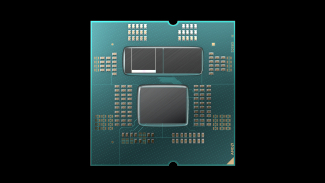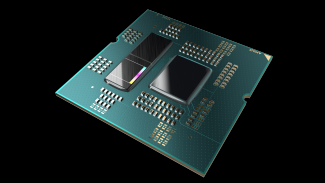For a long time, the best gaming CPU you could buy was the AMD 5800X3D. Not the more powerful 5900X, nor an Intel competitor, but a special edition with the 5800X’s 3D V-Cache.
In a nutshell, the reason comes down to the CPU’s cache – which is a small memory unit physically located near the CPU that can be read quickly – which is very important to the speed at which it can work with games. Usually there isn’t enough room in the cache because the CPU is a thin square with very limited area. AMD discovered, however, that you can do it vertically, rather than extending the cache to the side, and hence the designation 3D. So basically, it means you can throw three times as much cache on the CPU, which several outlets are calling the biggest technological innovation of the decade. It should be said, though, that it’s not just for gaming, servers and workstations can also benefit from it.
So everyone has been looking forward to AMD’s Ryzen 7000 series, especially since the 5800X and 5800X 3D dies didn’t get a replacement, just the 7700X and 7900X, but that magic middle ground didn’t exist at launch – but it does now. There are currently three options, the 7950X3D, the 7900X3D, and then the long-awaited 7800X3D, which doesn’t look like it’ll be available until early April. Still, it should be at least $150 less than the 7900X3D.
The price of the new 3D V-Cache version is slightly higher than the regular version, clocked at:
- AMD Ryzen 9 7950X3D: $699/€809
- AMD Ryzen 9 7900X3D: $699/€809
Here is an ad:
We have to look at the top model, the AMD Ryzen 9 7950X3D. But there’s also a 3D version of the 7900X die that probably makes the most sense for many because 16 cores and 32 threads is actually a lot more than you need and AMD’s acceleration technology is very simply Just crank up the processor speed until you hit some thermal limit.
But with the 3D V-Cache version, not only do we get 144MB of cache – which is a lot, but the power consumption is also greatly reduced, from 170 watts to 120 watts, but with the same or even better performance, so better Overclocking options, or just keeping the chip running hotter, I’m a big fan of it myself. Graphics cards and processors are very expensive, but if you can accept that they’re just running standard, rather than you having to pull a lot of extra watts through them for a 2% boost in performance, the system is usually both stable and lasts for years.
This system makes the processor die itself contain not only ordinary CCX, but also a die with 3D V-Cache. A CCX is a unit called a core complex, which contains four CPU cores and their shared cache, and the more CCX units, the more cores. Normally there is 16MB per CCX, but here’s more stuff up to 144MB. The point is that common tasks run fine, and high frequency is important, and the 3D V-Cache unit has extremely low latency due to the very high cache. This means you can reduce production costs and have a flexible and scalable system. While this sounds very complicated and automated, you can actually decide for yourself, maybe not what I would suggest since the system analyzes on the fly which core should do what, but you can choose.
Here is an ad:
AMD even has a separate system that automatically throws games to the best performing CCX device, which is usually the one with the most cache.
As many AMDers know, with the Ryzen Master software, you can make good use of the CPU and the corresponding performance. There are many different options, one of which is the “curve optimizer” – optimization takes some time, but it pays off. Combine that with Eco mode, where the CPU is limited in how much power it can draw, and you’re still close to 7-8% of what you can achieve at full power. Likewise, by precisely boosting the overdrive, you can perform one-click overclocking. It’s not like you’re earning 15-20% more, the system is already pushing as many cores as possible, but for those who want it, it’s only a few percent gain.
Not surprisingly, we tested this on an AM5 motherboard with DDR5 6000Mhz RAM, NVMe 4.0 drives and an RTX 4080 card. The reason is that we’re not 100% sure whether AMD’s Smart Access Memory works better with the 3D version, or “just” works the same as the regular X version, introducing an additional variable. So if we’re pairing it with one of the super tuned RX 7900 XTX cards that we also borrowed the numbers shouldn’t be taken as absolutes but they do give us a solid comparison to the 7950X with as few variables as possible Base.
We had no problem getting above 5.7Ghz on half of the cores, which makes perfect sense because these are cores without 3D cache and maybe more importantly, the temperatures are cool, for example, the whole core is below 74 degrees while using regular 7950X chip, it often climbs above 90 degrees under heavy load. Power consumption isn’t too shabby either, we measured 121.99 watts at peak when not fiddling with things – but I wonder if there’s more performance if you set it to consume free? So overall, it’s in 1080p and 1440p that you’ll see the biggest change, simply because the GPU is often the bottleneck for 4K gaming.
Overall, we see a 10-12% improvement at 1080p and a 7-10% improvement at 1440p. Some games can make better use of this cache than others, with Far Cry 6 improving by 48% at 1080p and 49.51% at 1440p – compared to a mere 4.2% improvement at 4K.
It costs more, but there is also a measurable improvement, which is then compensated by reduced power consumption. Unfortunately we haven’t had time to play with overclocking yet, but since there should be an extra 50 watts to play with, there’s huge potential for more performance. For example, if you already own a 7950X, there’s not much point in upgrading, especially if you’re using 4K resolution. But the extra 12 percent performance gain without a generational shift is worth it, even if it comes at an extra cost.


